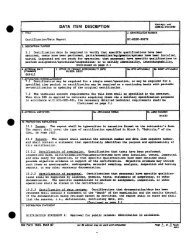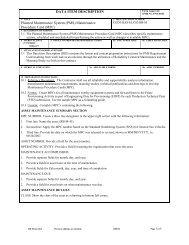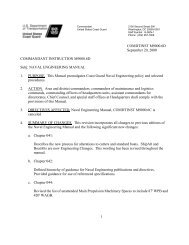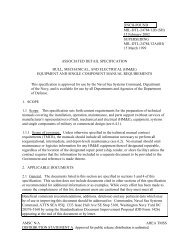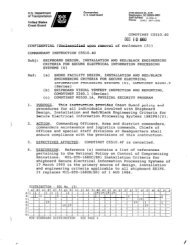comdtinst m2400.1f - US Coast Guard Response Boat-Medium
comdtinst m2400.1f - US Coast Guard Response Boat-Medium
comdtinst m2400.1f - US Coast Guard Response Boat-Medium
You also want an ePaper? Increase the reach of your titles
YUMPU automatically turns print PDFs into web optimized ePapers that Google loves.
CHAPTER 2. SEARCH AND RESCUE<br />
A. General.<br />
1. Initial Communication. Initial communications between<br />
vessels or aircraft in distress and the mobile units<br />
proceeding to their assistance is normally made on the<br />
frequency used by the vessel or aircraft making the distress<br />
call. In the case of merchant vessels equipped for<br />
radiotelegraphy, the initial contact frequency would normally<br />
be 500 kHz. In the case of small vessels voluntarily<br />
equipped with radiotelephone, such as fishing vessels and<br />
pleasure craft, the inter-ship frequencies (see Circuit L2.2)<br />
should be tried after attempts to call these vessels on 2183.4<br />
(2182) kHz and 156.8 MHz have been unsuccessful.<br />
2. Initial Contact. The initial contact frequencies allow the<br />
mobile search and rescue units to establish communications<br />
with aircraft or vessels in distress. After communications<br />
have been established, the selection of a frequency for<br />
handling traffic between the vessel or aircraft in distress<br />
and the rescue units proceeding to assist is the<br />
responsibility of the unit in distress or the station which<br />
has transmitted the distress message for the unit in distress,<br />
except when the control of distress traffic has been<br />
delegated to another station. Communications should be<br />
shifted to available working frequencies as soon as<br />
practicable, except when it is not possible to do so because<br />
of a lack of common frequencies. For communications involving<br />
only <strong>Coast</strong> <strong>Guard</strong> units regular <strong>Coast</strong> <strong>Guard</strong> frequencies should<br />
normally be used. In any event, due regard must be given to<br />
the guard requirements on the calling, distress and emergency<br />
frequencies.<br />
3. Aircraft. The first transmission of an aeronautical distress<br />
message is on the frequency in use for normal communications<br />
with the aeronautical stations at the time of the incident.<br />
For that reason, search and rescue craft proceeding to the<br />
assistance of the aircraft must establish communications on<br />
that frequency. It is necessary that search and rescue craft<br />
obtain pertinent frequency information from the controlling<br />
surface radio station, whether it be an International Civil<br />
Aviation Organization air-ground control radio station or a<br />
controlling military radio station. That frequency normally<br />
will be used for establishing initial communication as well<br />
as for handling ensuing communications between the distressed<br />
aircraft, assisting mobile craft, and the controlling surface<br />
radio station. When a mobile search and rescue unit is within<br />
line of sight range of a distressed aircraft the initial<br />
contact frequency would normally be either 121.5 MHz for<br />
civil aircraft or 243 MHz for military aircraft.<br />
2-1





